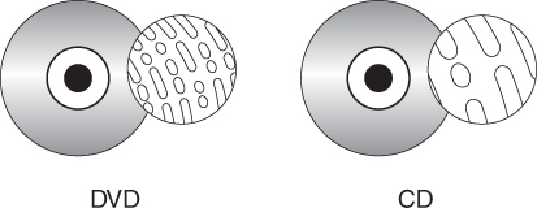Hardware Reference
In-Depth Information
• A slightly larger data area on the disc (8,605-8,759 square millimeters)
• About 1.06 times more efficient channel bit modulation
• About 1.32 times more efficient error-correction code
• About 1.06 times less sector overhead (2,048/2,352-2,048/2,064 bytes)
The DVD disc's pits and lands are much smaller and closer together than those on a
CD, allowing the same physical-sized platter to hold much more information.
Figure 11.9
shows how the grooved tracks with pits and lands are just over four times as dense on a
DVD as compared to a CD.
Figure 11.9
DVD data markings (pits and lands) versus those of a standard CD.
DVD drives use a shorter wavelength laser (650nm) to read these smaller pits and lands.
A DVD can have nearly double the initial capacity by using two separate layers on one
side of a disc and double it again by using both sides of the disc. The second data layer
is written to a separate substrate below the first layer, which is then made semi-reflective
to enable the laser to penetrate to the substrate beneath it. By focusing the laser on one of
the two layers, the drive can read roughly twice the amount of data from the same surface
area.
DVD Tracks and Sectors
The pits are stamped into a single spiral track (per layer) with a spacing of 0.74 microns
between turns, corresponding to a track density of 1,351 turns per millimeter or 34,324
turns per inch. This equates to a total of 49,324 turns and a total track length of 11.8km or
7.35 miles in length. The track is composed of sectors, with each sector containing 2,048
bytes of data. The disc is divided into four main areas:
•
Hub clamping area
—Thehubclampareaisjustthat:apartofthediscwherethehub
mechanism in the drive can grip the disc. No data or information is stored in that area.
•
Lead-in zone
—The lead-in zone contains buffer zones, reference code, and mainly a
control data zone with information about the disc. The control data zone consists of

